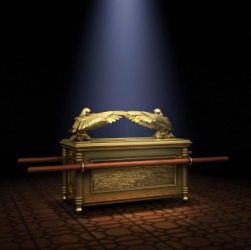People always ask me where I think the Ark of the Covenant is today and this question led me to carry out some deep research into the whereabouts of this ancient mystical relic. The Ark of the Covenant is one of the most fascinating of all Temple-related subjects. There are many theories about what happened to the Ark of the Covenant, and speculation abounds as to its actual location. Some people think it was taken to the Vatican, together with other Temple vessels, such as those depicted on the Roman monument, the Arch of Titus. There are many authentic, ancient historical chronicles, and even more popular legends, that attest to many sacred vessels having been taken away to Rome. However, this does not apply to the most holy feature of the First Temple, the Ark. Nevertheless, my research led me to two possible locations where the coveted Ark of the Covenant may be to today. One is in a small town in Ethiopia called "Aksum" and the other is under the "Temple Mount" in Jerusalem-under the Al-Aqsa Mosque!
They shall make an ark of acacia wood," God commanded Moses in the Book of Exodus, after delivering the Israelites from slavery in Egypt. And so the Israelites built an ark, or chest, gilding it inside and out. And into this chest Moses placed stone tablets inscribed with the Ten Commandments, as given to him on Mount Sinai. Thus the ark “was worshipped by the Israelites as the embodiment of God Himself,” writes Graham Hancock in The Sign and the Seal. "Biblical and other archaic sources speak of the Ark blazing with fire and light...stopping rivers, blasting whole armies." (Steven Spielberg's 1981 film Raiders of the Lost Ark provides a special-effects approximation.) According to the First Book of Kings, King Solomon built the First Temple in Jerusalem to house the ark. It was venerated there during Solomon's reign (c. 970-930 B.C.) and beyond. Then it vanished. Much of Jewish tradition holds that it disappeared before or while the Babylonians sacked the temple in Jerusalem in 586 B.C.
However, through the centuries, Ethiopian Christians have claimed that the ark rests in a chapel in the small town of Aksum, in their country's northern highlands. It arrived nearly 3,000 years ago, they say, and has been guarded by a succession of virgin monks who, once anointed, are forbidden to set foot outside the chapel grounds until they die.
It is interesting to note that Emperor Haile Selassie who was the last emperor of Ethiopia claimed to be the 225th monarch, descended from Menelik, the ruler believed responsible for Ethiopia's possession of the ark of the covenant in the tenth century B.C. The story is told in the Kebra Negast (Glory of the Kings), Ethiopia's chronicle of its royal line: the Queen of Sheba, one of its first rulers, traveled to Jerusalem to partake of King Solomon's wisdom; on her way home, she bore Solomon's son, Menelik. Later Menelik went to visit his father, and on his return journey was accompanied by the firstborn sons of some Israelite nobles—who, unbeknown to Menelik, stole the ark and carried it with them to Ethiopia. When Menelik learned of the theft, he reasoned that since the ark's frightful powers hadn't destroyed his retinue, it must be God's will that it remain with him.
Many historians—including Richard Pankhurst, a British-born scholar who has lived in Ethiopia for almost 50 years—date the Kebra Negast manuscript to the 14th century A.D. It was written, they say, to validate the claim by Menelik's descendants that their right to rule was God-given, based on an unbroken succession from Solomon and the Queen of Sheba. But the Ethiopian faithful say the chronicles were copied from a fourth-century Coptic manuscript that was, in turn, based on a far earlier account. This lineage remained so important to them that it was written into Selassie's two imperial constitutions, in 1931 and 1955.
In the second instance that relates to the most likely location of the Ark of the Covenant, it is interesting to note that tradition records that even as King Solomon built the First Temple, he already knew, through Divine inspiration, that eventually it would be destroyed. Thus Solomon, the wisest of all men, oversaw the construction of a vast system of labyrinths, mazes, chambers and corridors underneath the Temple Mount complex. He commanded that a special place be built in the bowels of the earth, where the sacred vessels of the Temple could be hidden in case of approaching danger. Midrashic tradition teaches that King Josiah of Israel, who lived about forty years before the destruction of the First Temple, commanded the Levites to hide the Ark, together with the original menorah and several other items, in this secret hiding place which Solomon had prepared. This location is recorded in Jewish sources, and today, there are those who know exactly where this chamber is. Jewish rabbis claim that the ark is still there, undisturbed, and waiting for the day when it will be revealed. An attempt was made some few years ago (in the early 1990s) to excavate towards the direction of this chamber. This resulted in widespread Moslem unrest and rioting. Jews claim that Muslims stand a great deal to lose if the Ark is revealed - for it will prove to the whole world that there really was a Holy Temple, and thus, that the Jews really do have a claim to the Temple Mount. (The official position of the Islamic Wakf, the body that governs over the Temple Mount, is that there never was a Holy Temple, and that the Jews have no rights whatsoever to the place).

